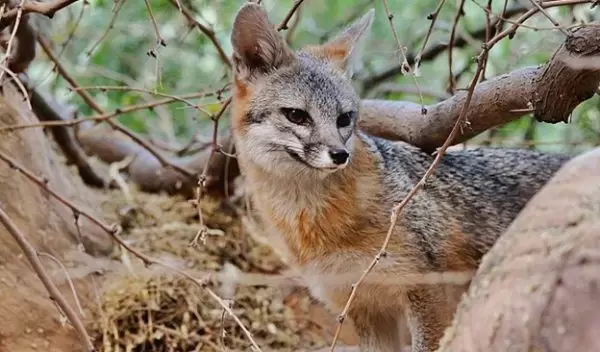
Tree cover helps gray foxes coexist with coyotes in rural areas
As coyotes have spread outside their native range into the eastern United States, they've been known to harass and kill North Carolina's two native species of fox. A new study finds that preserving tree cover may be essential in helping the gray fox survive with coyotes in rural areas, probably because of the fox's unusual ability to climb trees.
In the U.S. National Science Foundation-supported study, published in the journal Ecosphere, researchers used camera traps to find out where gray foxes coexist with coyotes in suburban, rural or wild areas of North Carolina. Surprisingly, they found gray foxes can coexist with coyotes in suburban forest fragments. However, in rural zones, gray fox avoid areas where coyotes live that lack adequate tree cover.
"Coyotes are well known to persecute smaller foxes," said study co-author Roland Kays at North Carolina State University. "They go out of their way, more than you see in other interactions between species, to bully, chase and kill the smaller foxes."
Coyotes have spread across North America from their native range in parts of the western U.S., taking advantage of the fact that larger predators -- such as cougars and wolves -- aren't found in most of the eastern U.S. anymore. "The general trend has been a decline in all carnivores, but there are some exceptions, and the coyote is one of the big exceptions," Kays said.
Researchers wanted to know how coyotes might impact where native species such as the gray fox are now found -- especially since urbanization could affect how the two species interact by fragmenting their habitats and disrupting food sources.
The researchers used wildlife photos taken by volunteers to figure out where foxes and coyotes coexist. The photos came from 915 motion-sensitive cameras that volunteers placed in yards, forest fragments and open areas in suburbs, dense suburbs, rural and wild areas. Researchers used the photos to develop a model of whether the two species are likely to be found together, and at what times.
"Understanding the behavior of elusive animals can be challenging, but this research demonstrates the value of 'many eyes' watching by using simple technology," said Liz Blood, a program director in NSF's Division of Environmental Biology. "This study highlights the value of participatory science. We all can be involved in better understanding the wildlife around us."
From 347 pictures of coyotes and 943 pictures of gray foxes, the scientists discovered that the two species are most likely to be found together in areas of high housing density and low forest cover -- the suburbs. Coyotes were generally less likely to live in high density housing areas than gray foxes.
